Economic Report on Scottish Agriculture, 2016
Presents an overall picture of Scottish agriculture using data from the various agricultural surveys that RESAS manage.
This document is part of a collection
5.3 Sheep
The number of sheep in Scotland has gone through a series of fluctuations in the past 125 years, with peaks in the thirties, the sixties and the nineties. Numbers have been just below seven million for the last seven years, levels last seen in the 1940s.
Chart 5.13: Number of sheep in Scotland, 1883-2015
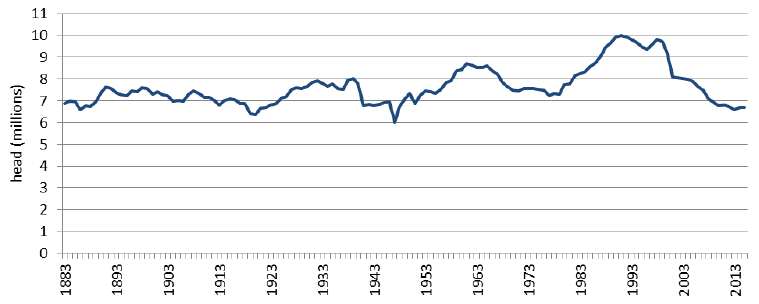
5.3.1 Distribution of sheep ( Table C10(i), C10(ii))
There were 6.70 million sheep in Scotland in June 2015. Areas with the highest numbers of sheep were the Scottish Borders (1.15 million or 17 per cent of the total), Dumfries and Galloway (1.03 million or 15 per cent), the Highlands (863,000 or 13 per cent), Grampian (630,000 or nine per cent) and Tayside (621,000 or nine per cent).
Chart 5.14: Distribution of sheep by sub-region, June 2015
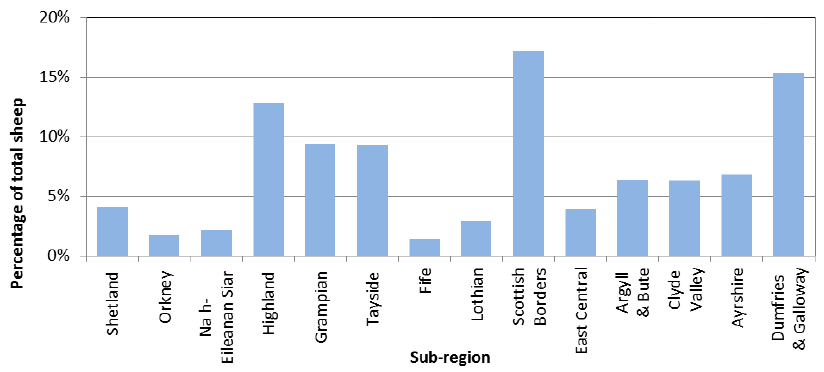
However, once you take into account the size of these sub-regions, Map 11 shows that, while one might associate the large areas of rough grazing in the Highlands with sheep farming, the highest concentration of sheep is to be found south of the central belt, and to a lesser extent on the east coast. The inset map within Map 11 also shows whether the sheep population in a parish is comprised mostly of lambs or older sheep. We can see that parishes with the higher proportions of lambs in June are located largely outwith upland areas, along the east coast and central belt and around coastal areas of the south west.
Map 11: Sheep per hectare in parish, 2015
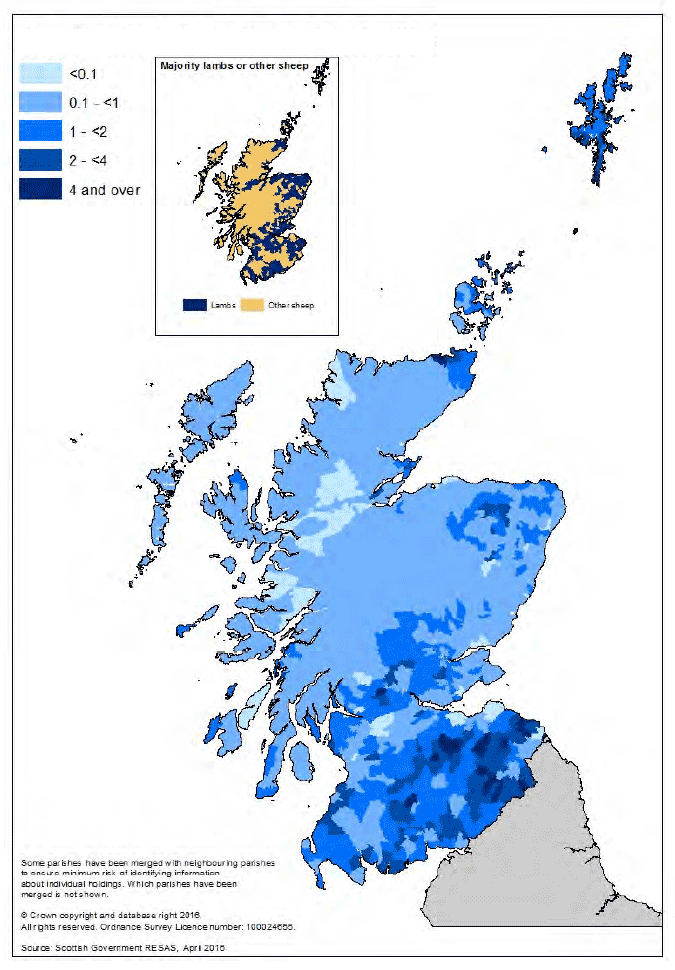
5.3.2 Size of sheep flocks ( Table C14)
There were 2.59 million breeding ewes in Scotland in June 2015, with the majority (1.49 million or 58 per cent) in flock sizes of 500 or more breeding ewes. These larger flock sizes were mostly located in the South East and South West.
Of the 12,661 holdings with breeding ewes, the majority (7,494 or 59 per cent) had flock sizes of less than 100 breeding ewes. However, these holdings only accounted for 227,800 (nine per cent) of breeding ewes in Scotland. Most of these holdings with smaller flock sizes were located in the North West.
Chart 5.15: Breeding sheep, by size group and region, June 2015
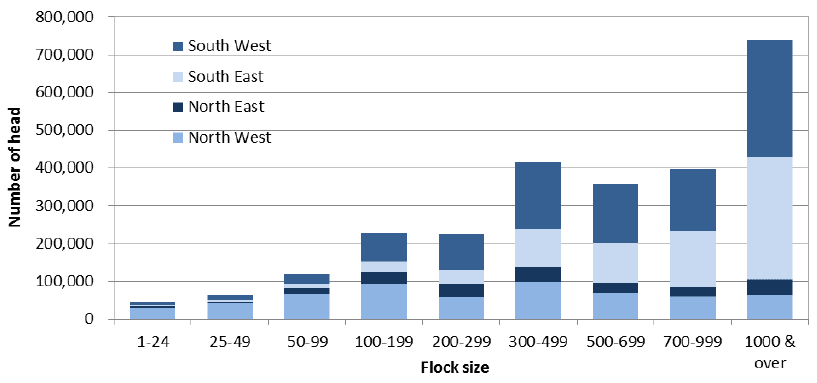
5.3.3 Income from sheep ( Table A5)
Sheep account for about seven per cent of income from farming. Since 2005, the value of income from sheep, including store sales but excluding related subsidies, has increased by £66 million (51 per cent) to an estimated £196 million in 2015 (see chart 5.1). Between 2005 and 2008 values remained fairly steady, averaging around £140 million. Between 2008 and 2009 there was a 36 per cent increase in value followed by smaller fluctuations in the years after that. 2014 saw a 12 per cent increase, followed by a 6 per cent decrease in 2015.
The volume of meat production over the past ten years has been mixed, with increases in one year being reversed the following year. Total production (including from older livestock), shown in chart 5.2, was eight per cent lower in 2015 than in 2005, at 57,000 tonnes, though slightly up on last year's level of production. Chart 5.16 similarly shows a decline in the production tonnage of finished lambs.
Chart 5.16: Finished lamb production and average price, 2005-2015
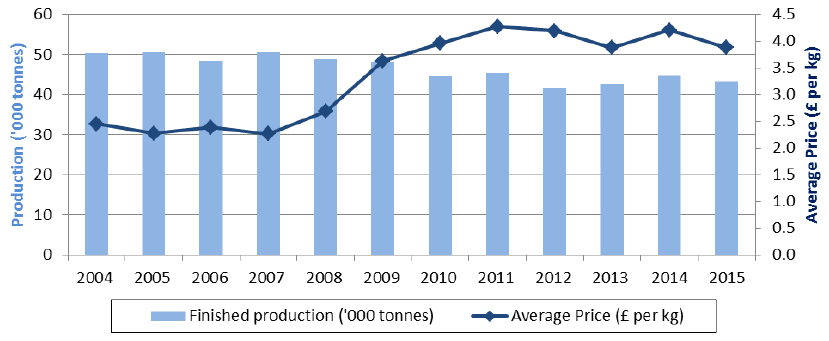
Chart 5.17: Monthly lamb prices in 2009, 2014 and 2015
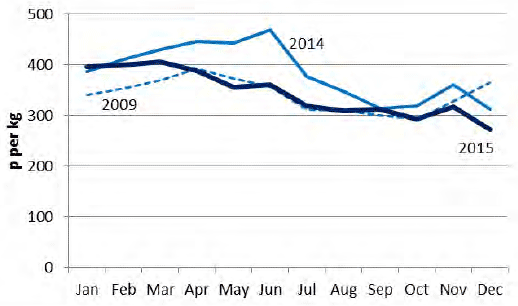
Prices started 2015 at 395p per kg in January and remained steady in the first quarter of the year, followed by price drops, ending the year on 272p per kg.
5.3.4 Income from wool ( Table A6)
Chart 5.18: Income from wool, 2005-2015
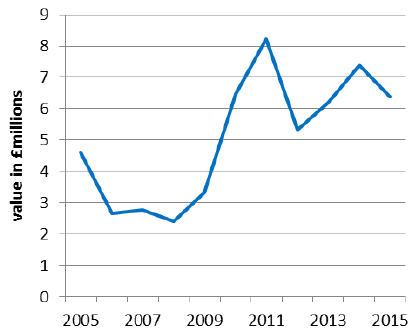
Income from wool only accounted for about £6.4 million in 2015 - income from sheep meat was 33 times greater. The value of wool has however increased greatly since 2008, due to a considerable increase in price. Within that period there have been peaks in 2011 and 2014.
Chart 5.19: Wool production and average price, 2005 to 2015
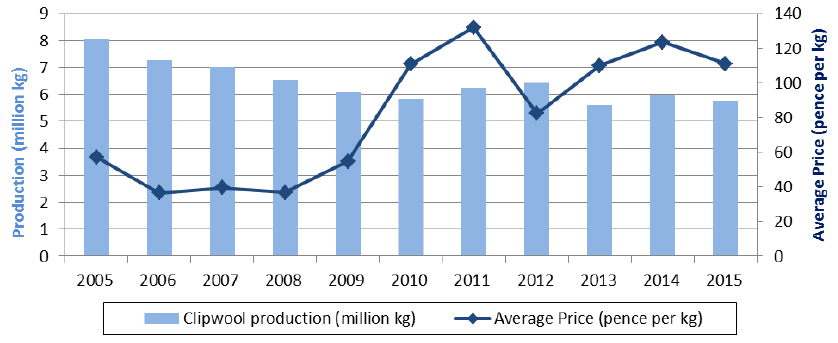
5.3.5 Specialist sheep ( LFA) FBI ( Table B1)
Accounting for inflation, between 2009-10 and 2014-15, the average FBI of specialist sheep ( LFA) farms decreased by around 65 per cent. This decrease was due to a rise in spending on inputs, especially inputs other than direct livestock inputs and a fall in livestock revenue.
In the last year, revenue for specialist sheep ( LFA) farms decreased, along with a fall in revenue and a decrease in the value of subsidy payments, leading to a decrease in profits. The FBI value of specialist sheep ( LFA) farms was £12,000 in 2014-15.
The average FBI/ FTE for specialist sheep ( LFA) farms of £9,000 is roughly equivalent to an hourly wage for unpaid labour of £4.88, around two thirds of the minimum agricultural wage ( MAW) in Scotland. Around 55 per cent of specialist sheep ( LFA) farms generated incomes equivalent to less than the MAW, whereas three per cent generated more than five times MAW.
At £36,000 high performing specialist sheep farms generated incomes roughly three times the overall average. The fall in FBI for the upper quartile reflects this change to the sample. Low performing farm businesses made an average loss of £7,000.
The total average revenue for specialist sheep ( LFA) farms, including income from diversification and subsidy payments, was £89,000. Spending on inputs averaged at £77,000. The largest portion of the input costs were due to "other inputs" such as machinery, land and buildings costs and those related directly to livestock production (such as feed).
If subsidies were excluded, losses were recorded in each of the last six years. There is a generally worsening trend, with losses ranging from £8,000 in 2009-10 to £21,000 in 2014-15.
Over the last year, cost centres for specialist sheep ( LFA) farms show a decrease in profits from agricultural, diversification and direct payment cost centres. There have been small increases in profits from agri-environment and contracting activities.
Specialist sheep ( LFA) Farms
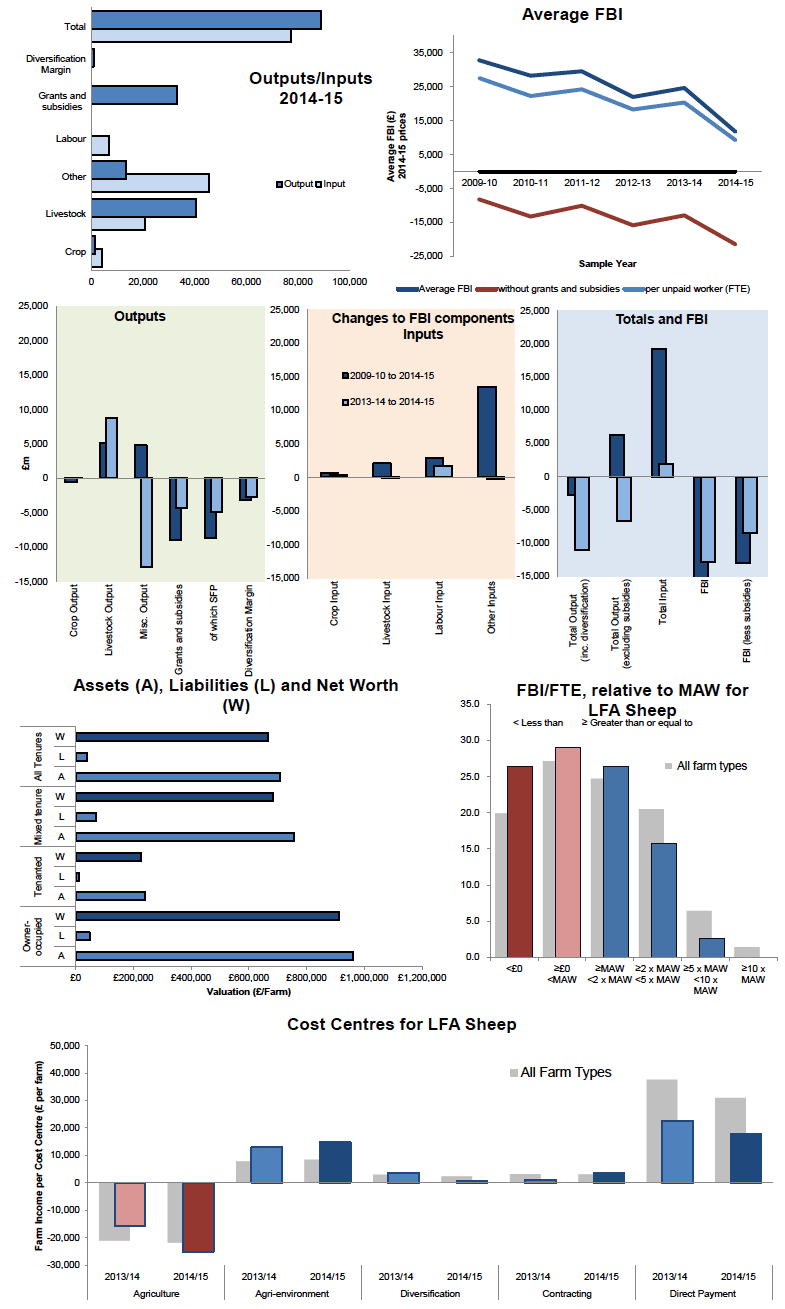
The average net worth (assets minus liabilities) of specialist sheep ( LFA) farms was £668,000 in 2014-15. The average debt ratio (liabilities:assets) remained unchanged at six per cent overall and ranged between five per cent for owner-occupied farms and 10 per cent for mixed tenure farms.
5.3.6 Sheep enterprises ( Table B12)
Overall average gross margins for sheep enterprises ranged from £17 per head for store lamb finishing (long keep) to £51 per head for lowland production.
Where sample sizes were sufficient to allow comparisons between high and low performers, we can see that low performing sheep enterprises generated considerably lower margins. Low performing extensive hardhill enterprises made a loss of £5 per head on average, while long keep store lamb finishing enterprises broke even. High performing store lamb production and lowland sheep production enterprises made six and seven times the margins, respectively, of low performers in their groups. High performing store lamb producers made an average margin of £73 per head. High performing lowland sheep producers made and average £91 per head.
For sheep enterprises, differences in gross margins between high and low performers are due to lower variable costs, value added to stocks, and higher sales prices per head which is expected to reflect generally higher quality outputs between the performance groups.
All sheep and lamb enterprises experienced increases in their overall average gross margin per head since 2013-14. Increases to margins ranged from £2 per head for long keep store lamb finishing to £32 per head for lowland sheep production. Across all sheep enterprises, increases in production value (reflecting better market prices) contributed to increased gross margins, despite increased spend on variable costs in some enterprise groups.
Taking account of the size of the enterprises, crossbred ewe production (£28,000) and finished/store lamb production (£23,000) achieved the highest average overall gross margins. Extensive/hardhill, lowland and long keep store lamb finishing enterprises (£7,000) achieved lower average gross margins. However, all sheep enterprises saw increased overall average margins compared to 2013-14, with extensive/hardhill enterprises showing a noticeable improvement.
In contrast to gross margin results, the group average output:input ratios (the return achieved per £1 spent) ranged from 1.6 for extensive/hardhill enterprises to 2.4 for long keep store lamb finishing (almost all sheep enterprise groups experienced an increase in the average output:input ratio compared to 2013-14).
More detailed results, including sample size information, are available from the agriculture statistics web page, Enterprise Performance Analysis [12] .
Sheep: Enterprise Gross Margin Measures
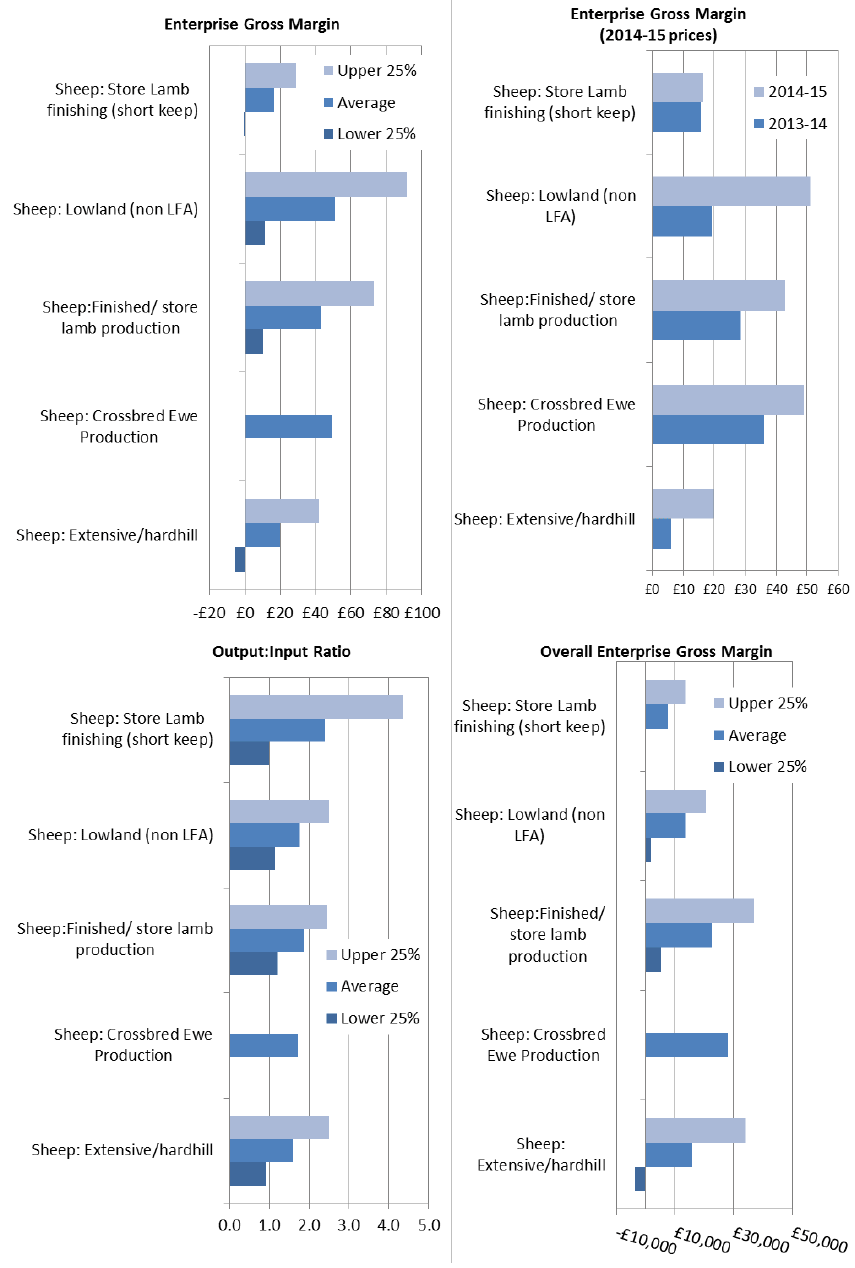
5.3.7 Other cattle & sheep ( LFA) FBI ( Table B1)
Accounting for inflation, between 2009-10 and 2014-15, the average FBI of other cattle and sheep ( LFA) farms decreased by around 44 per cent, although there has been some fluctuation between these years. This decrease was due to a rise in spending on inputs, especially direct livestock costs, such as feed, medicine, machinery and depreciation costs.
In the last year, reduced spending on inputs for other cattle and sheep ( LFA) farms has outweighed decreased revenue (notably subsidy payments) to slightly lift the average FBI for these farms. The FBI value of other cattle and sheep ( LFA) farms was £26,000 in 2014-15.
The average FBI/ FTE for other cattle and sheep ( LFA) of £16,000 is roughly equivalent to an hourly wage for unpaid labour of £8.67, almost equivalent to one and a quarter times the minimum agricultural wage ( MAW) in Scotland. Around 39 per cent of other cattle and sheep ( LFA) farms generated incomes equivalent to less than the MAW, whereas four per cent generated more than five times MAW.
At £86,000 on average, high performing other cattle and sheep ( LFA) farms generated incomes more than three times the overall average. Low performing farm businesses made an average loss of £300.
The total average outputs for other cattle and sheep ( LFA) farms, including income from diversification and subsidy payments, was £164,000. Spending on inputs averaged at £138,000. The largest portion of the input costs was due to feed and "other inputs" such as machinery and land and buildings.
Excluding subsidy, over the last six years losses would be recorded in each year. They ranged from losses of £19,000 in 2009-10 to their highest of £37,000 in 2012‑13. Since 2012-13, FBI without subsidy payments has seen the losses recovering to £26,000 in 2014-15.
Over the last year, cost centres for other cattle and sheep ( LFA) farms show an increase in income from agricultural activities, while direct payments and income from contracting activities has fallen. There was little change in incomes from agri-environment activities and diversification.
The average net worth (assets minus liabilities) of other cattle and sheep ( LFA) farms was £1.1 million in 2014-15. The average debt ratio (liabilities:assets) remained unchanged at 12 per cent for LFA cattle and sheep farms but ranged between 10 per cent for owner-occupied and 16 per cent for mixed tenure farms.
Other Cattle & Sheep Farms ( LFA)
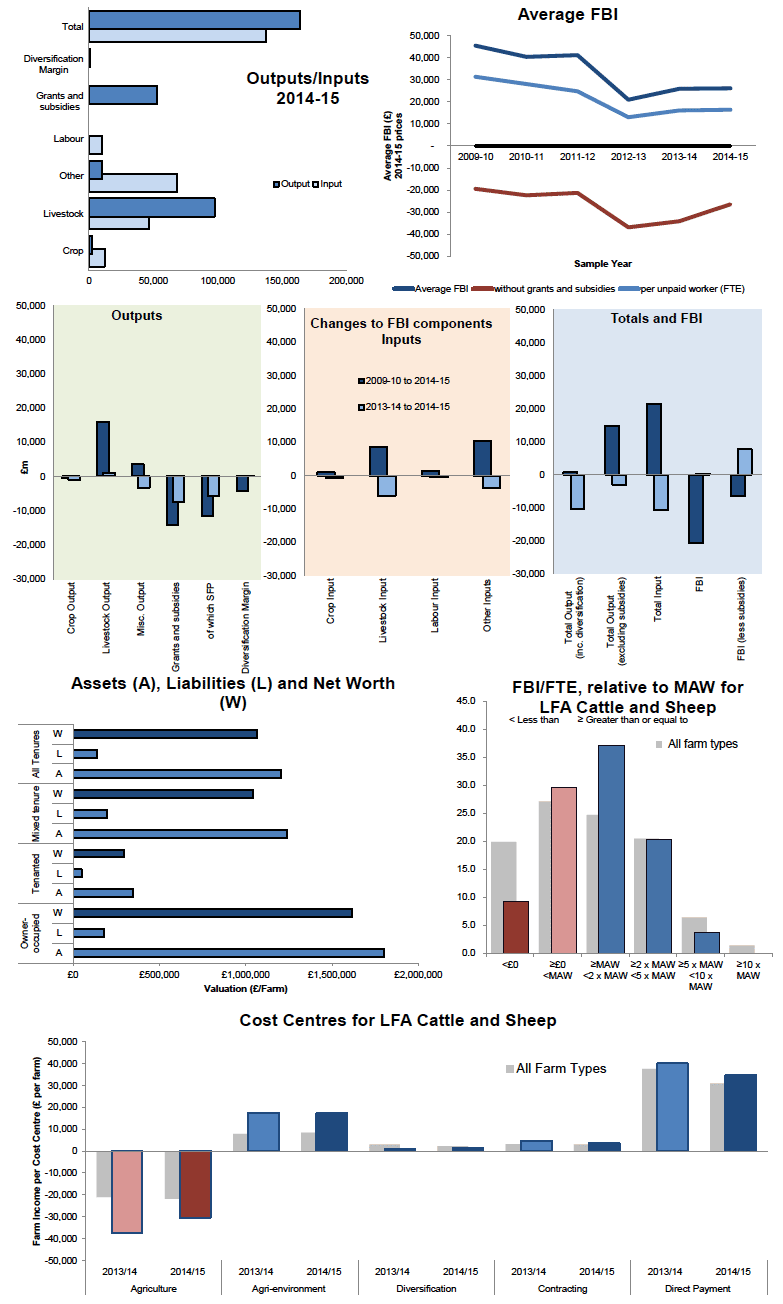
5.3.8 Lowland cattle & sheep FBI ( Table B1)
Accounting for inflation, between 2009-10 and 2014-15, the average FBI of lowland cattle and sheep farms decreased by around 40 per cent, though this has improved over the last two years from the lowest value of £18,000 in 2012-13. This was due to an increase in the spending on inputs for livestock, machinery, land and buildings and a decrease in the value of subsidy payments.
In the last year both spending on inputs and revenue for lowland cattle and sheep farms have decreased. The reduction in spending on inputs was slightly greater than that of revenue and resulted in an overall increase in FBI value for 2014-15 despite reduction in subsidy payments. The FBI value of lowland cattle and sheep farms was £26,000.
The average FBI/ FTE for lowland cattle and sheep farms of £17,000 is roughly equivalent to an hourly wage for unpaid labour of £9.17. Around 62 per cent of lowland cattle and sheep farms generated incomes equivalent to less than the minimum agricultural wage ( MAW), whereas seven per cent generated more than five times MAW.
At £68,000, on average, high performing lowland cattle and sheep farms generated incomes roughly two-and-a-half times the overall average. Low performing farm businesses made an average loss of £7,000.
The total average revenue for lowland cattle and sheep farms, including income from diversification and subsidy payments, was £170,000. Spending on inputs averaged at £144,000. The largest portion of the input costs was due to feed and other inputs such as machinery and land and buildings.
Over each of the last six years, FBI without subsidy payments has been negative. It has ranged from a loss of £24,000 in 2012-13 to a loss of £6,000 in 2010-11. Over the last year, FBI without subsidy payments has reduced its losses from a figure of £18,000 to £11,000.
Over the last year, cost centres for lowland cattle and sheep farms show an increase in income from agricultural activities and diversification, while direct payments have fallen. There has been little change in other cost centres over the year.
The average net worth (assets minus liabilities) of lowland cattle and sheep farms was £1.1 million in 2014-15. The average debt ratio (liabilities:assets) remained unchanged at 10 per cent for lowland cattle and sheep farms but ranged between nine per cent for owner-occupied and 17 per cent for mixed farms.
Lowland Cattle & Sheep Farms
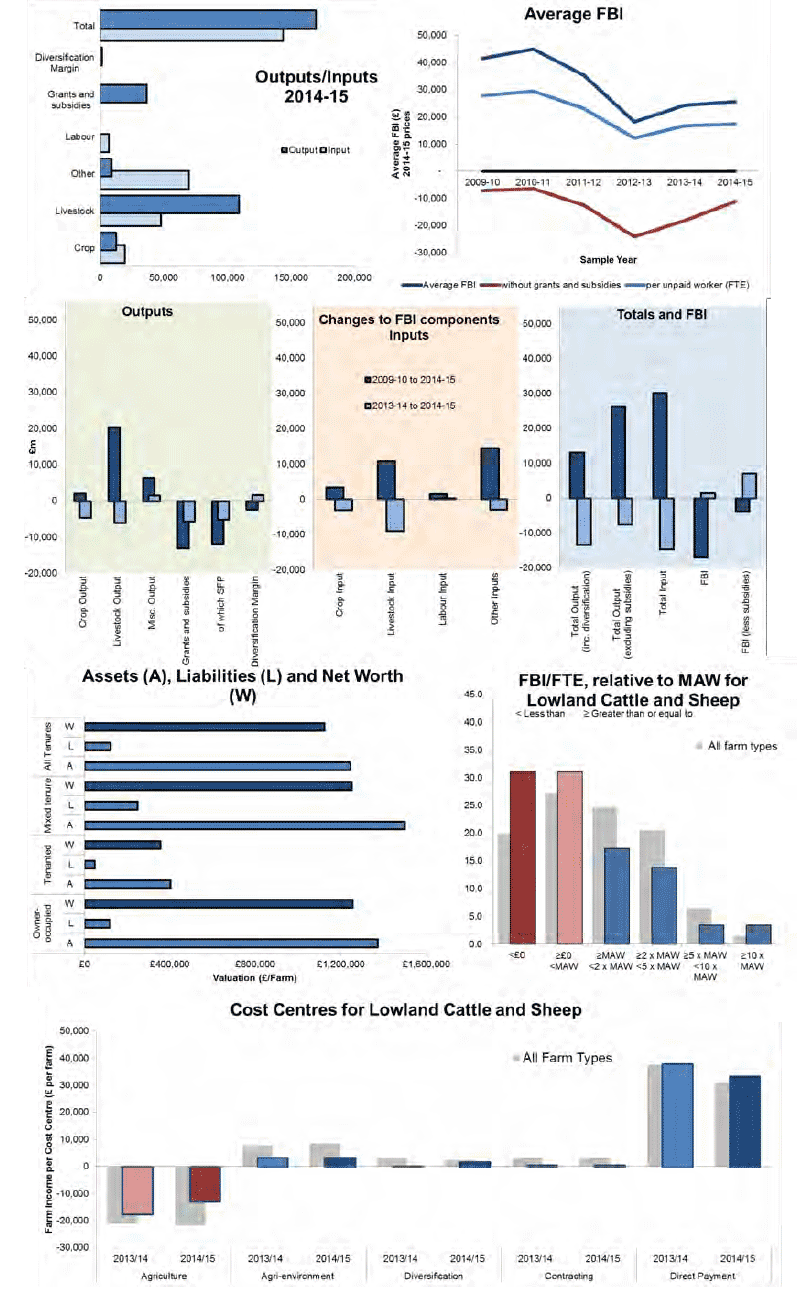
Contact
There is a problem
Thanks for your feedback